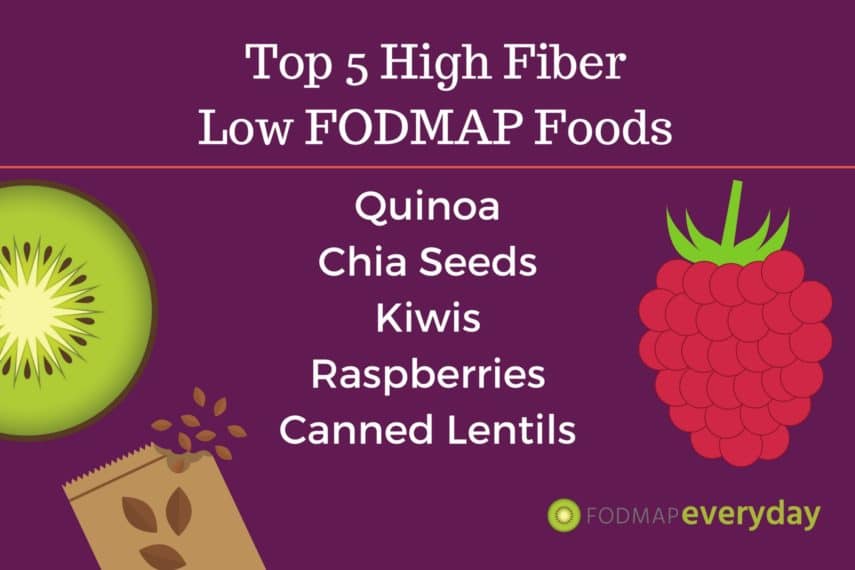Are You Getting Enough Fiber?
For years, dietitians have been promoting the importance of getting enough fiber in the diet. However, one of the challenges with the low FODMAP diet is the lack of choices for high fiber foods. This is a common concern as people begin this type of therapeutic diet.
Since so many fruits and vegetables are restricted because of the high FODMAP content, how can you get enough fiber each day?
How Much Fiber?
Exactly how much fiber should we be getting in our diet each day? Take a look at this chart to see where you fall. This might seem like a big number, but you will learn here how easy it is to get enough, even if you are on a low FODMAP diet.
How To Add Fiber To Your Diet
Once you figure out how much fiber you should be getting each day, it’s important that you don’t go from zero to, let’s say 30 grams, overnight. Your gut will not thank you. This is something that should be done slowly over time. A good start is to increase by a few grams of fiber.
This might look like a serving of raspberries on your lactose-free yogurt for lunch. After a couple of days, add a few more grams of fiber. Eventually over a period of a couple weeks, you should be at your target fiber range. As you increase your intake of fiber, keep in mind that you should also be drinking more water.
Fiber 101
Now that you have a better idea of how to add more fiber, let’s look at fiber in more detail. Fiber is only found naturally in plant foods. It’s the part of the plant that our bodies can’t absorb.
So, it basically just passes through the digestive tract. There are two main types of fiber: soluble and insoluble.
Soluble fiber dissolves in water and helps to lower blood cholesterol and glucose levels. Foods that are higher in soluble fiber include: oatmeal, peanuts, sesame and sunflower seeds.
On the other hand, insoluble fiber helps to bulk things up and move material through the digestive system. Eating foods such as whole grains, kale, eggplant and raspberries will help ensure you are getting enough insoluble fiber.
It’s important to have both kinds of fiber in our diet, and fortunately, most plant foods such as fruits, vegetables, whole grains and legumes contain a mix of these fibers.
Why Fiber Is Important
We often hear that we should be getting enough fiber in our diet, but why is it so important? For people suffering from constipation, fiber can help your bowels become more regular. Fiber can make it easier to maintain a healthy weight.
Eating foods like fruits and vegetables that contain fiber make us feel more satisfied and less likely to overeat. Fiber can also help lower the risk of heart disease and diabetes.
For those suffering from a digestive condition such as irritable bowel syndrome, fiber can make a difference in the type and variety of bacteria found in your gut. Each of us has over 100 trillion bacteria living in our gut.
And the average American adult has over 1,200 different species of bacteria, which is pretty incredible. In order to keep a balance between good and bad bacteria in the gut, it’s important to eat a wide variety of foods that have fiber.
You May Want To Read: Fiber and IBS: What You Need To Know for a deeper dive into this important subject.
My Top 5 High Fiber Low FODMAP Foods:
-
Quinoa (1 cup cooked (155 g), 5 grams fiber)
Quinoa makes a great replacement for oatmeal as a hot breakfast. Add some fruit and cinnamon for extra flavor. You can also use quinoa as a stuffing for vegetables such as peppers, zucchini, or squash.
-
Chia seeds (2 tablespoons (24 g), 10 grams fiber)
Chia seeds are not only a great source of fiber, but also contain omega-3 fatty acids and some minerals like magnesium and calcium. One of my favorite ways to use chia seeds is to add them to a low FODMAP smoothie. They also taste great added to a salad. Try making a quick chia pudding for breakfast by mixing them with coconut or lactose-free milk the night before. If you are looking for a substitute for eggs in baking, 1 tablespoons of chia seeds mixed with 3 tablespoons of water works well.
-
Kiwi fruit (2 small, 5 grams fiber)
The easiest way to enjoy kiwi fruit is simply to eat it as-is. In fact, if you want even more fiber, eat the skin, too. Kiwi fruit tastes great in a low FODMAP smoothie and pairs well with bananas. If you are looking for something a little different, try using it to make a tropical salsa that can be used over grilled chicken or fish.
-
Raspberries (½ cup (about 10), 3.5 grams fiber)
Raspberries pack in plenty of antioxidants and phytonutrients along with fiber. Sprinkle them over a bowl of oatmeal or a lactose-free yogurt for breakfast. Raspberries can be used to make flavored ice cubes to jazz up your water. You can also blend them with lactose-free yogurt and freeze into popsicles for a quick summer treat.
-
Canned lentils (¼ cup (46 g), 5.2 grams fiber)
Canned lentils are a great convenience food to keep in your pantry. They can be added to chili or soup for extra fiber, protein, and iron. Lentils can be used as a substitute for meat in burgers or tacos.
One of the easiest ways to get more fiber in your low FODMAP diet is to add Low FODMAP Monash Certified REGULAR GIRL. Read all about this insoluble fiber supplement you can add to almost any meal in our interview with Molly Lawson from Regular Girl.
You Don’t Have to Go Without Fiber!
As you can see, following a low FODMAP diet doesn’t have to mean that you skimp on fiber. There are plenty of high fiber choices that are also low in FODMAPS.
With so many benefits for eating fiber, why not get started today and see how your digestion changes over time. You might be surprised by how good you feel.
References
Department of Gastroenterology, Central Clinical School, Monash University and the Alfred Hospital, Melbourne, Victoria, Australia. The Monash University Low FODMAP Diet. 2010. Print.
Kuo, Shiu-Ming. “The Interplay Between Fiber and the Intestinal Microbiome in the Inflammatory Response.” Advances in Nutrition (2013): 16-28. Web. 4 May 2017.
Sonnenburg, Justin PhD, and Erica Sonnenburg PhD. The Good Gut. New York: Penguin Books, 2015. Print.
U.S. Department of Health and Human Services and U.S. Department of Agriculture. 2015 – 2020 Dietary Guidelines for Americans. 8th Edition. Web. 6 May 2017. (note: this reference used for table above)











I’ve never given much thought on high fiber low fodmap foods not until now.
I was just diagnosed with IBS a few months ago. And was now on the Low FODMAP diet. I’ve always struggled with the question, ‘What foods can I eat on the low FODMAP diet?”” before.
These were some great high fiber low fodmap foods that I’d love to try! I’ve also found some great low fodmap food options here https://casadesante.com/blogs/low-fodmap-life/low-fodmap-restaurant-meal-options
Great post as always! Thanks!
All the best,
Amy
I’m just readingthat depending on your condition you should focus on either soluble fiber (slows digestion down) or insoluble fiber (speeds up). So it’s counterintuitve to me that if I have a condition where I need to think about fiber I would generically eat “fiber”. I don’t see on your descriptions of fiber rich foods which have more of one or the other. The soluble fiber foods listed at the beginning aren’t really anything you can eat a lot of – “oatmeal, peanuts, sesame and sunflower seeds.” And I even think oatmeal may be recommended against on a low fodmap diet, so now I’m left with peanuts and some seeds….. is there a longer list of soluble fiber foods? I’ve been taking citrucel but it’s expensive and just realized it’s only giving me 2 g of fiber anyway, plus a bunch of carbs unless I want the one with synthetic sugar (NO, why would anyone? Where is the “plain”???) thank you!
Hi Becky, I will answer this a few ways: Firstly, the article was written by a Monash trained RD who is very much aware of what foods are appropriate for the diet. Oats are low FODMAP in ½ cup (52 g) amounts, which is actually a generous serving. That makes a lot of oatmeal! Peanuts can be eaten in 28 g portions, which works out to be about 32 peanuts – again, that’s a generous serving size. This is all based on Monash lab tested results for low FODMAP servings. That said, as we speak, another fiber article is in the works written by Monash trained RD Vanessa Cobarrubia, so perfect timing to poke us! Look for that soon. And lastly, the diet, of course, is meant to be undertaken with a dietitian. Everyone’s system is unique and a RD can help tailor the approach that you need. Also take a look at our article on Regular Girl; you might find that interesting. In the meantime, please download the Monash app, so that you can have info at your fingertips – like that about the oatmeal – from the developers of the diet. There are too many incorrect reference materials out there and if you are using something that told you oatmeal was not okay, I would take a look at the source.
No.6 : Oranges Not just low formap & high fiber, also high calcium!!! and full of joy
No7: big Portion Spinach, 500g are well tolerated, add up to quite some Fiber and Magnesium
No.8 Big portion Green Beans
No.9 pumpkin seeds
Hi Juliane, This article was meant to be a quick snap-shot focused on fiber and yes, of course, many whole foods are nutritious from several perspectives. We try and stick with low FODMAP portion recommendations for those on their Elimination Phase, which would be 75 g for spinach (although as you mention individual tolerance may allow more), 75 g of green beans which is about 15 of them, and 2 Australian tablespoons (23 g) of pumpkin seeds
Thanks so much for these suggestions. I’ve been on a low fodmap diet for a couple weeks and have been missing the fiber I’m
used to eating! I will definitely be using these ideas.
So glad we could be of help! Take some time to peruse our other articles. We have hundreds written by Monash trained RDs addressing everything from fiber to supplements, budget to breastfeeding!
there is no differentiation between ibs d and ibs c, can you explain how this relates to these two issues. Thanks
Hi Caz, perhaps read our articles specific to IBS-D, IBS-C and also Fiber. Let us know if these help.